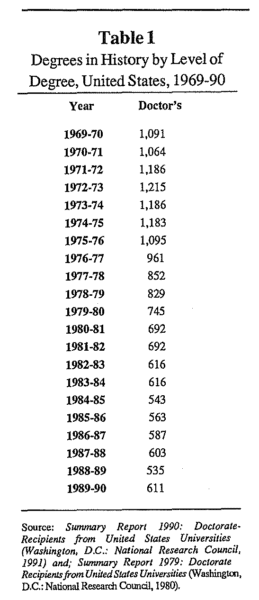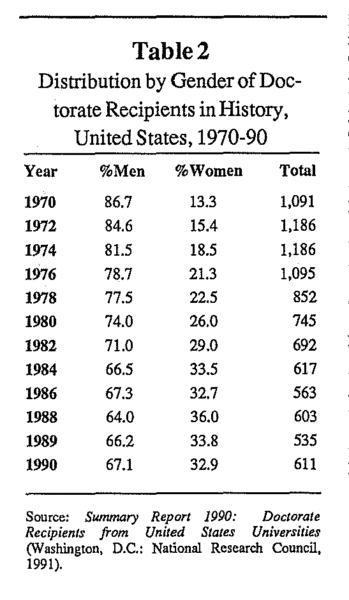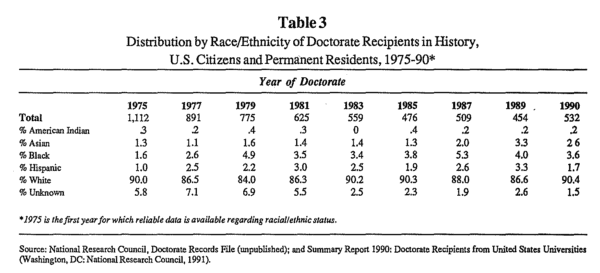According to a report issued by the National Research Council earlier this fall, the number of new doctorates awarded in history rebounded in 1990, partially offsetting the drop reported for 1989. In 1989, the number of Ph.D.s awarded in history fell by 11.3 percent from the previous year to 535, the lowest number in two decades. NRC’s 1990 survey reports 611 new history doctorates, an increase of 14.2 percent over the previous year.
 While at first glance the 1989 drop may appear to be simply a statistical fluke or aberration in an otherwise upward growth curve in history doctorates, a closer look suggests that may not be the case. Although the 1990 figure is the highest reported since 1984, it does not fully offset the 1989 decline. The average of the 1989 and 1990 figures is only 573, below that reported for the two previous years. Adding in the 1988 figure brings the average up a bit higher to 583, but that is still below that reported for the previous year. In other words, the ups and downs of the last three years average out below that of 1987, suggesting that the growth in the number of new history doctorates is stalled.
While at first glance the 1989 drop may appear to be simply a statistical fluke or aberration in an otherwise upward growth curve in history doctorates, a closer look suggests that may not be the case. Although the 1990 figure is the highest reported since 1984, it does not fully offset the 1989 decline. The average of the 1989 and 1990 figures is only 573, below that reported for the two previous years. Adding in the 1988 figure brings the average up a bit higher to 583, but that is still below that reported for the previous year. In other words, the ups and downs of the last three years average out below that of 1987, suggesting that the growth in the number of new history doctorates is stalled.
But there is potential for renewed growth for the fifth consecutive year1 the U.S. Department of Education reports increases in the numbers of B.A.s and M.A.s awarded in history. The number of B.A.s has increased by 38.5 percent since the low point in 1985, and the number of M.A.s is up 21.9 percent. Over half the latter increase—11 percent—came in 1990. Moreover the Council of Graduate Schools (CGS) report that graduate enrollment in history for the 1989–90 academic year increased by 6.9 percent, the third annual increase since CGS began collecting data in 1986. That is the largest increase in an humanities discipline and well above the 3.2 percent for the humanities overall and 2.5 percent of all fields. Graduate enrollment in history has grown 17.2 percent from 1986–87 to 1989–90, the largest increase in any humanities discipline an exceeding that for all humanities (9.4 percent) and all fields (5.9 percent). What is unclear is when these graduate students will earn their degrees (M.A. and Ph.D.) and what the status of the job market will be at that point.
 While we might welcome growth in the number of new Ph.D.s in history as an indication of revived confidence in the profession and an end to the slump of the 1970s and 1980s, we are probably better off with no growth in the annual output of new doctorates until the employment situation improves sufficiently to deal with the backlog of unemployed or underemployed history Ph.D.s as well as new recipients. No one knows if or when that will happen. A year ago there appeared to be significant improvement more EIB ads than in previous years, and more activity in the Annual Meeting Job Register. But the recession is clearly taking its toll, and the best we can hope for this year is stability in the job market. Although it is too early to report on the Job Register, data on EIB ads is now available. While the number of ads placed in the September issue was actually up slightly from last year, the number of ads placed in subsequent issues fell of considerably. Overall, the number of position announcements dropped 9.5 percent, virtually wiping out the 11.9 percent increase reported las year, Nevertheless, the number of ads still exceeds that placed in 1989—a fairly strong showing given the nation’s dismal economic situation.
While we might welcome growth in the number of new Ph.D.s in history as an indication of revived confidence in the profession and an end to the slump of the 1970s and 1980s, we are probably better off with no growth in the annual output of new doctorates until the employment situation improves sufficiently to deal with the backlog of unemployed or underemployed history Ph.D.s as well as new recipients. No one knows if or when that will happen. A year ago there appeared to be significant improvement more EIB ads than in previous years, and more activity in the Annual Meeting Job Register. But the recession is clearly taking its toll, and the best we can hope for this year is stability in the job market. Although it is too early to report on the Job Register, data on EIB ads is now available. While the number of ads placed in the September issue was actually up slightly from last year, the number of ads placed in subsequent issues fell of considerably. Overall, the number of position announcements dropped 9.5 percent, virtually wiping out the 11.9 percent increase reported las year, Nevertheless, the number of ads still exceeds that placed in 1989—a fairly strong showing given the nation’s dismal economic situation.
The recession has certainly muddied the waters—the duration of the recession and its long-term impact on higher education budgets and academic hiring must now be factored in with predictions regarding faculty retirement and student enrollments in the latter half of the decade, And of course, competition for jobs will continue to vary by field specialization.
The NRC also provides a demographic profile of the 1990 history doctorates. As in 1989, the percentage of history Ph.D.s earned by women declined in 1990, dropping to 32.9 per cent, below that reported for the previous three years (see Table 2). As in the past, history continues to lag behind other humanities disciplines in achieving parity—the percentage of humanities doctorates overall awarded to women increased in 1990 to 45.6.

The percentage of history doctorates awarded to individuals from racial and ethnic minorities (U.S. citizens and permanent residents) also declined—from 10.8 percent in 1989 to 8.1 percent in 1990. As Table 3 demonstrates, there has been no clear pattern in recent years in regards to the share of Ph.D.s earned by minorities—the percentage goes up one year, down the next, then back up again. Given the small percentages here, it is often more useful to look instead at changes in the actual number of recipients within each group. For example, between 1989 and 1990 the difference in the percentage of doctorates awarded to Hispanics is only 1.6 when compared to the entire population of Ph.D. recipients, but that represents a drop from fifteen recipients to 9, or a difference of 40 percent in the actual number of Hispanics receiving Ph.D.s. These numbers are even more meaningful within the context of the total population of history Ph.D.s. According to the NRC, of the 22,700 doctorates awarded in history in the U.S. since 1946, only 351 have been awarded to Hispanics. While a variation of six may be of little consequence in the context of the larger history doctorate population, it is of considerable significance for the smaller Hispanic cohort. The data on minority recipients contrasts dramatically with that for white recipients—the percentage of doctorates awarded to the latter increased from 86.6 percent in 1989 to 90.4 percent in 1990, meaning 88 more white recipients in 1990, over twice the total number of minority recipients that year. In the humanities overall, 9.1 percent of the 1990 doctoral recipients were minorities; for all fields, the percentage of minority recipients was 12.1. Despite efforts within the discipline to foster diversity, history continues to lag behind, failing even to reach the meager levels of minority participation attained in other disciplines.
For more information, contact the Doctorate Records Project, National Research Council, 2101 Constitution Ave., NW, Washington, DC 20418.

